My dream matchup for the Series remains possible. The Cubs need to finish off the Dodgers at Wrigley this weekend. As I discussed in Hot Stove #25 and #26, my sentiment with the Cubs relates to the obscenely long time since their last World Series win. To give that some personal perspective: My grandparents immigrated to the United States from Eastern Europe in 1907. That year and the next, the Cubs won the World Series. Our family has expanded by five additional generations since then (yes, I have great-grandchildren), but the Cubs remain without another World Series title. It’s time. Here is another take based on the opening number of Hamilton: (click here, 3:47).
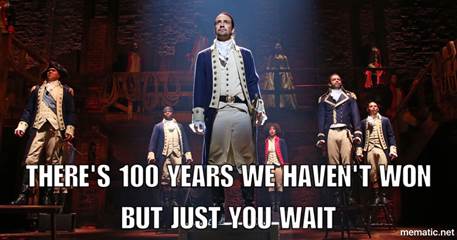
I am also drawn to the Cleveland Indians. They have likewise waited an extended time for a title, but at least I was alive the last time they won. It was 1948 and I was 7, a budding baseball fan. Although I did not recognize it at the time, that 1948 Cleveland team featured four of my favorite Hall of Famers: Owner Bill Veeck, outfielder Larry Doby and pitchers Bob Feller and Satchel Paige. The player-manager was Lou Boudreau who would become better known to us in Kansas City as the manager of the Athletics for the first three years after their move to KC from Philadelphia (1955-1957). Before getting to that 1948 season, I am going to step back two years to set the stage.
1946 Season: This was the first season since 1941 that teams did not lose players to the war effort. The 1941 season had been a golden year for the American League. Yankee Joe DiMaggio hit in 56 straight games. Ted Williams hit .406 for Boston. Bob Feller won 25 games for the Indians. The top three in the MVP voting: Joe, Ted, Rapid Robert. All three then lost years to the war. Fast forward to 1946. Williams was the MVP for the AL champion Red Sox. Feller won 26 games for Cleveland, but the team finished 36 games behind Boston. The Red Sox then lost in the World Series to the Cardinals who were led by National League MVP Stan Musial.
Feller was a phenom when he joined the Indians as a 17-year old in 1936. He struck out 17 batters in one game, breaking Rube Waddell’s AL record and tying Dizzy Dean’s NL record. Maybe even more impressive, he was the first known Major Leaguer to strike out his age – 17 K’s at age 17. [It has happened only one other time – in 1993, 20-year-old Kerry Wood of the Cubs struck out 20.] After the 1936 season, Feller returned home to Van Meter, Iowa, to finish high school. His fame was already so big that his graduation was broadcast nationally on NBC radio. In 1938, he struck out 18 in a game to become the then all-time leader. In 1940, he hurled the only opening day no-hitter in history. In 1946, he struck out 348, a new season record, surpassing Rube Waddell’s 343 in 1904 [BUT, later research of 1904 boxscores boosted Waddell to 349; Nolan Ryan, Sandy Koufax and Randy Johnson have since passed Feller and Waddell].
The other big news for Cleveland was that they had a new owner. Bill Veeck had been in baseball since he was a boy working for his father who was President of the Chicago Cubs from 1918 to 1933. Veeck held various baseball positions and owned a minor league team in Milwaukee in the early 40’s. In 1946, he bought the Cleveland Indians and started his maverick tenure as a baseball owner never fully appreciated by the baseball establishment – but loved by the fans. He added promotions that had worked for him in Milwaukee, including using Max Patkin, the “Clown Prince of Baseball” as a coach (Max was the clown in Bull Durham). The establishment was not amused.
Another memorable part of 1946 was the “Boudreau Shift” (a/k/a the “Williams Shift”). Teams had sometimes shifted defensive players in the past, and one of the earliest was also a “Williams Shift” for Cy Williams of the Phillies in the 1920’s. Indians manager Lou Boudreau took the tactic to a new level in an attempt to contain Ted Williams. Ted said the shift may have taken 15 points off his average, and he initially would not even try to hit to the open left side of the field. Cardinals manager Eddie Dyer used variations of the shift in the 1946 World Series, and Williams hit only .200 (5 for 25) with no extra-base hits. The really sad part of this is that it was the only World Series in Williams’ career. The photo below shows Williams hitting to left against the shift – the pitcher is Bob Feller.
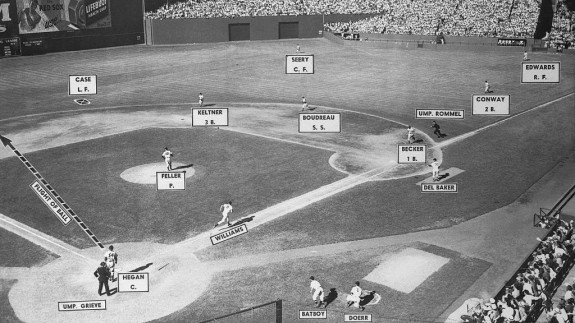
[Shift Update: Shifts against pull hitters have been common over the years, and the manager with the most shifts a few years ago was Joe Maddon, then with Tampa Bay. His team employed about 10% of all shifts in the majors. With more analytical info available, the use of shifts has exploded to 28,074 in 2016, a 1,040% increase from six years ago. Oddly, Maddon (now with the Cubs) had the least shifts in 2016, only 1.4% of the total. However, Maddon and his staff are very active from pitch-to-pitch on “defensive positioning” – the subtle changes of right/left and back/in for the situation. This puts the fielders in the way of more batted balls, and the Cubs are the best at this (to be specific, they convert 74.5% of batted balls into outs).]
After the end of the 1946 season, Veeck made a trade that that turned out to be a win-win. The Yankees got pitcher Allie Reynolds and the Indians got Joe Gordon, one of the top second basemen of all time. Veeck said “We just won the pennant.” He was only one year off. As for Reynolds, he went on to help the Yankees win six World Series.
Barnstorming – Feller, Satch and Dizzy: For several decades, players barnstormed after the season to make extra money. The Major Leagues did not play west or south of St. Louis, and barnstorming took star baseball players to many new fans. In 1927, after the Yankees won the World Series, Babe Ruth and Lou Gehrig formed teams to play each other at exhibitions around the country: the “Bustin’ Babes” and the “Larrupin’ Lou’s.” The two Yankee greats also barnstormed in 1928, and at a stop in Des Moines, Iowa, 9-year-old Bob Feller went to the game with his dad and bought one of the Ruth/Gehrig autographed baseballs. [That ball is today exhibited at the Bob Feller Museum in Van Meter, Iowa, per sportswriter Joe Posnanski who grew up in Cleveland and appreciates the Feller legacy. Click here.]
[Feller was not the only person to get an autographed ball from Ruth and Gehrig in 1928. This photo shows them handing a ball to Al Smith who they were supporting for President. Smith lost to Hoover.]
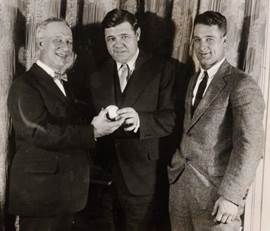
The big barnstorming tours of the 30’s and early 40’s featured teams led by Dizzy Dean and Satchel Paige. The Major Leagues were not integrated, but barnstorming had no such rules. Satchel and Dizzy were poor boys from Dixie and two of the most colorful ballplayers in the country. Dean was not outspoken on racial equality, but he had picked cotton next to blacks as a child and did not see why sharing a diamond with them should kick up a fuss. Their barnstorming exhibitions drew big crowds, and Bill Veeck, a 20-year old college dropout, attended one of those games in Los Angeles in early November of 1934. As Veeck recounts in my favorite baseball biography, Veeck as in Wreck, it was the greatest game he ever saw. It went 13 innings with Dean and Satch pitching the whole game. Dean fanned 15 and gave up only one run. Satch fanned 17 and pitched a shutout. Veeck thought at the time, that if he ever had the chance, he’d bring Satchel Paige to the big leagues. Some of this may be romanticized, but the rest of the story is quite real.
Bob Feller had seen barnstorming teams as a kid and played in many post-season exhibition games before and after the war. For example, the Sporting News reported on a game in St. Louis in October of 1941: “The magnet of a duel between Bob Feller, Cleveland fireball mound ace, vs. Satchel Paige, king of all Negro pitchers, attracted a paid crowd of 10,124 to Sportsman’s Park.”
Feller was a life-long promoter, and he saw barnstorming as a way to make money and gain more fame around the country. In 1946, he put together a team of all-stars from the Major Leagues and also set up a second team that would be their primary opponent. He knew that Satchel Paige would be a big draw and so asked J. L. Wilkinson, owner of the Kansas City Monarchs, to put together a team of Negro Leaguers to join Satch.
The traveling contingent also included a trainer and baseball clowns Jackie Prince and Max Patkin. Feller leased two planes and the fuselages were painted with the Feller and Paige all-star team names. Stan Musial joined the tour after the Cardinals finished winning the 1946 World Series. Eight Hall of Famers played: Feller, Musial, Phil Rizzuto and Bob Lemon on the Feller team. Paige, Hilton Smith, Wendell Brown and Monte Irvin on the Paige team. Paige’s team also included Buck O’Neil. The tour was a huge success and many players, especially the Negro Leaguers, made more money than they had during the regular season. Musial said he made more on the tour than he was paid for his World Series games.
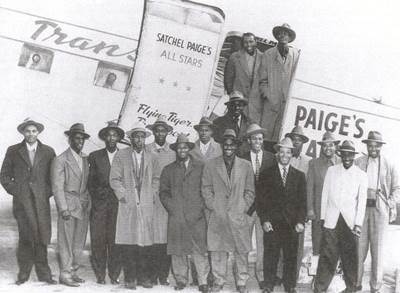
1947 Season: Bill Veeck made a major change in stadium use in 1947. For many years, the team played most of its games in 22,500-seat League Park, while playing some selected games in the cavernous 78,811-seat Municipal Stadium. Veeck decided that his franchise would be more viable if all games were played at Municipal. This would prove to be a very wise move. He also considered another big move – trading player-manager Lou Boudreau to the St. Louis Browns. The fans raised such an uproar that Veeck relented and signed Lou to a 2-year contract. Then in July, against the wishes of many AL league owners, Veeck broke the AL color line by signing Larry Doby from the Negro Leagues. Doby was not as successful as Jackie Robinson was in the NL that first year, but stardom was on the way.
Cleveland had a winning record and moved up to 4th place in 1947. Feller went 20-10 and Boudreau was third in the MVP vote. DiMaggio edged out Ted Williams for MVP. The Yankees won the pennant and played Jackie Robinson’s Dodgers in the first integrated World Series. The Yankees won, 4 games to 3.
1948 AL Pennant Race: The Big Three on Cleveland’s pitching staff were Bob Lemon (20 wins), Gene Bearden (20) and Bob Feller (19). The lineup was strong with Lou Boudreau, Joe Gordon and Ken Keltner each knocking in over 100 runs. Larry Doby hit .301 in his first full year. Boudreau hit .355 and was named MVP, beating out DiMaggio and Williams to become the first shortstop to receive the award. Another key player was Satchel Paige who Veeck signed on July 7. Paige had hoped that some team would sign him at the beginning of the 1948 season, but no offers came. Jackie Robinson had been joined by Roy Campanella on the Dodgers, but no other team added a black player in 1948. Three other black players had played briefly in 1947, but were not on any 1948 roster. So, when Paige signed with Cleveland, there were only four black players, two each for Brooklyn and Cleveland. Below, Feller and Satch.
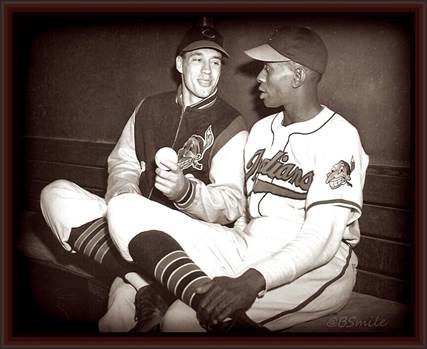
Many other owners considered the Paige signing a typical Veeck stunt, and the Sporting News editorialized that “to sign a hurler of Paige’s age is to demean the standards of baseball…if Satchel were white, he would not have drawn a second thought from Veeck.” Veeck countered that if Satch were white, he would have been in the majors 25 years earlier. The 42-year-old rookie proved the naysayers wrong. Satch finished with a record of 6-1 and an ERA of 2.48. But his enduring achievement was at the gate. In his first start on August 3, the Indians drew 72,434 fans (average attendance for the year was 33,598). His next start was in Chicago, and 50,013 fans jammed Comiskey Park, the largest night game crowd in history. That record lasted only a week. On August 20, Satch was back in Cleveland and drew 78,382 for a night game.
The Yankees and Red Sox had been the early favorites, but Cleveland made a run and all three were at 91-56 with seven games to go. On the next-to-last day of the season, the Yankees were eliminated and Cleveland held a one game lead over Boston. On the final day, Cleveland lost and Boston won, putting both teams at 96-58. This set up the first-ever one-game playoff in AL history. Playing in Boston, the Indians won 8-3.
1948 World Series: After the win at Fenway, the Indians did not have to leave town for the World Series. Their rival was the Boston Braves (moved to Milwaukee in 1953 and then Atlanta in 1966). The Braves hopes rested on two great pitchers, Warren Spahn and Johnny Sain. Beginning on September 6, they started 11 of Boston’s next 16 games. Spahn went 4-1 and Sain 5-1. And like “Tinker to Evers to Chance,” they were rewarded with a sportswriter’s poem (Gerry Hern in the Boston Post): “First we’ll use Spahn, then we’ll use Sain / Then an off day, followed by rain / Back will come Spahn, followed by Sain / And followed, we hope, by two days of rain.” The popularized shortened version was “Spahn and Sain and pray for rain.”
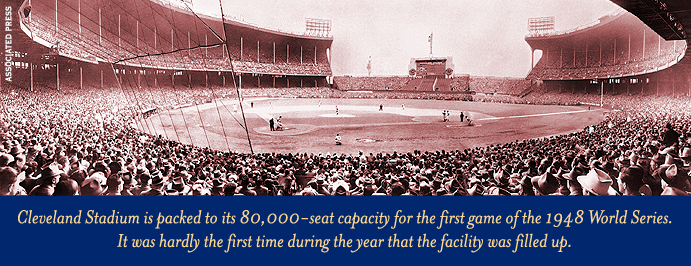
Feller opened the Series for the Indians and allowed only two hits and one run, but Spahn threw a shutout. The Indians then had three pitching gems (4-1, 2-0 and 2-1). The winning hit in Game 4 was a homer by Larry Doby, the first-ever by a black player in a World Series. Game 5 was in Cleveland and drew 86,288 fans, a major league record. Feller started for the Indians, and the game was tied 5-5 going into the 7th. Feller and two relievers then gave up six runs in the inning to put the game out of reach. Satchel Paige came in and belatedly stopped the rally by getting the last two outs in the inning. This was the only appearance by Satch, but it was a milestone as he became the first black pitcher in a World Series game. As for Feller, he took the only two losses for the Indians in the Series. Like Ted Williams, he would only appear in one World Series, and they each suffered subpar stats.
The teams went back to Boston for Game 6, and Bob Lemon won his second game of the Series, 4-3, making the Indians the champions for the first time since 1920. In the team photo below, Boudreau and Veeck are 5th and 6th from the left on the first row, Feller and Paige are 3rd and 4th from the right in the second row. Doby is 4th from the left on the back row.
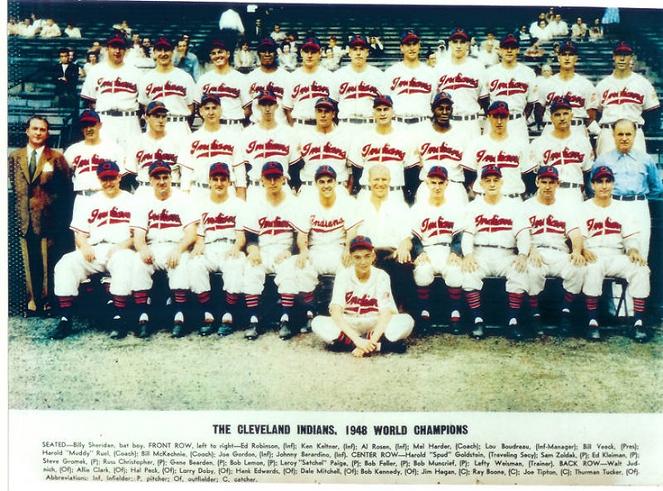
Veeck’s Wreck of the Yankee Dynasty: In the 18 seasons from 1947 to 1964, the Yankees won the AL pennant 15 times (Rizzuto, Mantle, Yogi, and so many other greats). The three years they did not win all related to Bill Veeck. The 1948 story is told above. After the 1949 season, Veeck was forced to sell the team to fund his divorce settlement. The team he had put together continued to do well, finishing in the first division the next eight years and taking the pennant in 1954. Doby led the league in homers and RBI’s in ’54, but the Indians were swept by the Giants in the World Series. Everyone has seen a play from that Series: “The Catch” by Willie Mays. Veeck’s third pennant was as the owner of the “Go-Go Sox” of Chicago in 1959. They lost to the Dodgers in the World Series.
Ted Williams and Satchel Paige: When Ted Williams was inducted into the Hall of Fame in 1966, he touched a nerve with this: “I hope that someday the names of Satchel Paige and Josh Gibson in some way could be added as a symbol of the great Negro players that are not here because they were not given a chance.” And it was done. Paige would be the first, in 1971. When Larry Doby was voted into the Hall in 1998, he first received word about his election in a phone call from Ted Williams.
Baseball Curses: The Chicago Cubs have not been in a World Series since 1945 (lost to the Tigers). Some say it is the “Curse of the Billy Goat” placed on the Cubs by a tavern owner who was not allowed to bring his pet goat into Wrigley for a 1945 Series game. The Red Sox won a World Series in 1918 behind the pitching arm and bat of Babe Ruth, but they traded him away in 1919, starting a long era when they did not win the Series – the “Curse of the Bambino.” This curse ended in 2004 when the Red Sox swept the Cardinals.
Not as commonly known are two curses that are said to keep Cleveland from winning. The “Curse of Rocky Colavito” relates to two trades of the same player. Rocky was a slugging star for the Indians from 1955 to 1959, but GM Frank “Trader” Lane traded him to Detroit for 1959 batting champion Harvey Kuenn. Kuenn lasted only one year with the Indians, but Rocky continued to bang out lots of homers for Detroit. Rocky went to the Kansas City Athletics in 1964, and then a three-way trade took him back to Cleveland. In that trade, Cleveland gave up Tommy John and Tommie Agee to the White Sox. Colavito gave two more good years to the Indians. John, who had two career wins when traded, went on to win another 286. Agee was the AL rookie of the year with the White Sox in 1966 and then was a star for the 1969 Miracle Mets. May not be a curse, but definitely not good trades.
The “Curse of Chief Wahoo” posits that the team will not win a World Series until it ends the use of a Native American caricature as a logo. Some see the logo as harmless tradition. Others see it as a racist image akin to Little Black Sambo. The original team use of the logo ironically started with Bill Veeck, the owner who integrated the American League. For many years, Native American caricatures had been used by newspapers to identify the team. In 1947, Veeck had a young artist design a logo, and it was used on the uniforms in 1948 (see Satchel/Feller photo above). Sensibilities about racial and ethnic matters have changed a lot from the 40’s, resulting in some bitter exchanges about the logo. Team owner Larry Dolan in 2016 said that Chief Wahoo would become a “secondary” logo and changed the cap design to a block “C”. But the caricature remained on the sleeve and on loads of merchandise in the team store. The controversy is far from over and is also sometimes extended to the use of “Indians” as a team name. A Toronto radio sportscaster refused to call them the “Indians” during the ALCS games this year. Also, Chief Wahoo was back in prime space in the ALCS version of the Indians baseball cap. In another irony, when Allie Reynolds was traded away by Veeck for Joe Gordon in 1946, the team lost not only a good pitcher, it lost a member of the Creek nation who went by the nickname Superchief. More Chief Wahoo history here.
More on Chicago: Ted Williams and Bob Feller are two of the greatest players in the history of the game, but each only got to play in one World Series. It was even worse for “Mr. Cub.” Ernie Banks played for the Cubs from 1953 to 1971 and was never in the post-season. Ernie died at age 83 last year, but fans will always remember his quote, “It’s a beautiful day for a ball game…let’s play two!” Ernie came to the Cubs by way of the Kansas City Monarchs where Buck O’Neil was involved in signing Ernie to a contract. Ernie: “Playing for the Kansas City Monarchs was like my school, my learning, my world. It was my whole life.” When the Cubs made Buck the first black coach in the majors, his first assignment was to sign Banks. Below, Ernie is making the double play pivot over a sliding Jackie Robinson.
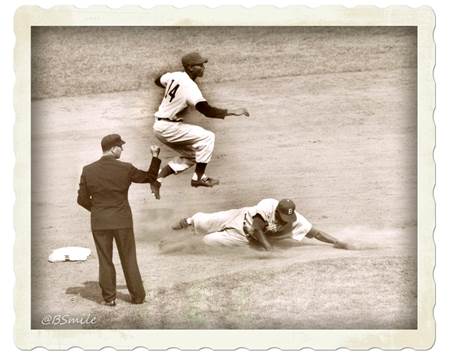
Chicago was the home of Chess Records, and Chess was in the news twice this week. On Tuesday, one of my original rock ‘n’ roll idols, Chuck Berry, turned 90. In 1956, I bought (and still have) “Roll Over Beethoven,” recorded on the iconic Chess record label. Chess was based in Chicago where Leonard and Phil Chess produced a string of rock ‘n’ roll hits in the 50’s. Phil Chess died this past week at age 95. There has been a lot of talk about whether or not Bob Dylan should have been awarded a Nobel Prize for literature, but the treatment of song lyrics as literature is not a new concept. For example, a new song lyrics category was established in 2012 by the prestigious PEN organization. The inaugural awards for PEN went to Chuck Berry and Leonard Cohen. Dylan remarked at the time that Chuck Berry was the Shakespeare of rock ‘n’ roll. Leonard Cohen’s response on the award, “The thing I like about this award is that I’m sharing it with Chuck Berry. ‘Roll Over Beethoven and tell Tchaikovsky the news’. I’d like to write a line like that.” Amen Leonard. Sing it Chuck.
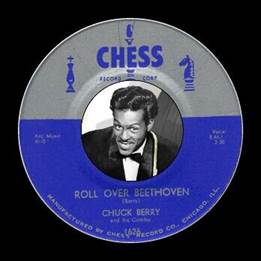
To end this, I am going to forward a link sent to me by former Mets pitcher and Kansas City native Bill Wakefield. Wake’s choice for the World Series would have been the Mets, and failing that, the Royals, Giants or Cards. I asked Wake who he now favored, and he sent this musical response. He feels this way even though Ron Santo and Ernie Banks took his pitches “into the ivy during day games” at Wrigley.
Go Cubs!